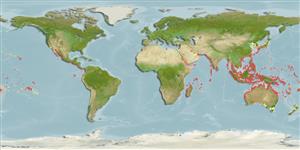Common names from other countries
Environment: milieu / climate zone / depth range / distribution range
Sinh thái học
; Mức độ sâu 0 - 20 m (Ref. 349). Tropical
Indo-Pacific.
Length at first maturity / Bộ gần gũi / Khối lượng (Trọng lượng) / Age
Maturity: Lm ? range ? - ? cm Max length : 6.0 cm SHL con đực/không giới tính; (Ref. 349); common length : 5.0 cm SHL con đực/không giới tính; (Ref. 349)
Collected in large quantities, for food and for the shell (Ref. 349). Abundant on sandy bottoms. Occurs at the low tide mark (Ref. 349). Naticidae are carnivorous prosobranchs which drill holes on their prey such as limpets, barnacles, and other molluscs, especially bivalves (Ref. 833).
Life cycle and mating behavior
Chín muồi sinh dục | Sự tái sinh sản | Đẻ trứng | Các trứng | Sự sinh sản | Ấu trùng
Members of the order Neotaenioglossa are mostly gonochoric and broadcast spawners. Life cycle: Embryos develop into planktonic trocophore larvae and later into juvenile veligers before becoming fully grown adults.
Poutiers, J.M. 1998. (Ref. 349)
IUCN Red List Status (Ref. 130435)
CITES status (Ref. 108899)
Not Evaluated
Not Evaluated
Threat to humans
Harmless
Human uses
| FishSource |
Các công cụ
Các nguồn internet
Estimates based on models
Preferred temperature
(Ref.
115969): 24.4 - 29.3, mean 28.4 (based on 3700 cells).
Vulnerability
Low vulnerability (10 of 100).
Price category
Unknown.
